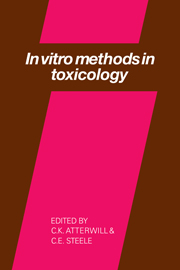In vitro dermal irritancy tests
Published online by Cambridge University Press: 06 August 2010
Summary
INTRODUCTION
Current methods for predicting the dermal irritation potential of new compounds to man rely mostly on in vivo techniques. The method most commonly employed is based on that designed by Draize and co-workers (1944) using the visual assessment of oedema and erythema produced in rabbit skin after topical application of a test substance (Hood et al. 1977). Other workers have favoured the use of other species (using essentially similar methodology), such as the guinea pig and mouse (Hood et al. 1977).
One of the major disadvantages of in vivo predictive dermal irritancy tests is the subjectivity associated with visual assessment and interpretation of the dermal response. This is best illustrated by Weil and Scalafs report (1971) of blind testing a range of dermal irritants in an interlaboratory collaborative study using a standardized Draize assay. The results from 25 laboratories revealed high inter and intralaboratory variability in scoring and rating the test compounds as irritants. In some cases this was so extreme that a compound listed as most irritating by some laboratories was listed as least irritating by others.
There have been some attempts to improve the objectivity of in vivo dermal irritant assessment.
- Type
- Chapter
- Information
- In Vitro Methods in Toxicology , pp. 279 - 298Publisher: Cambridge University PressPrint publication year: 1987
- 8
- Cited by



